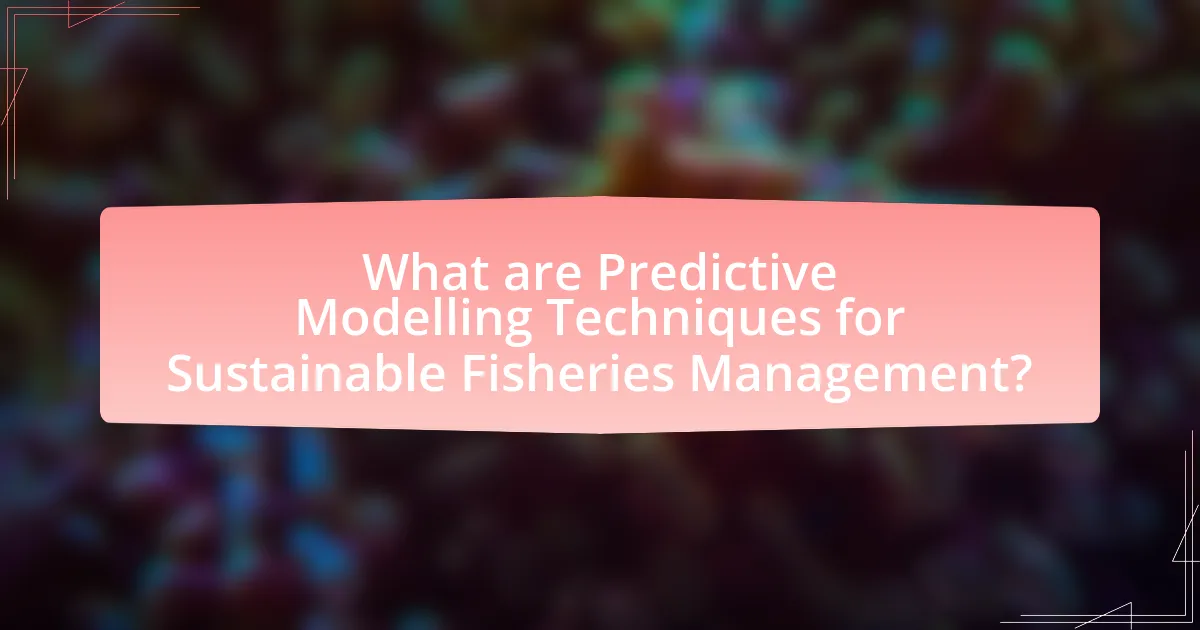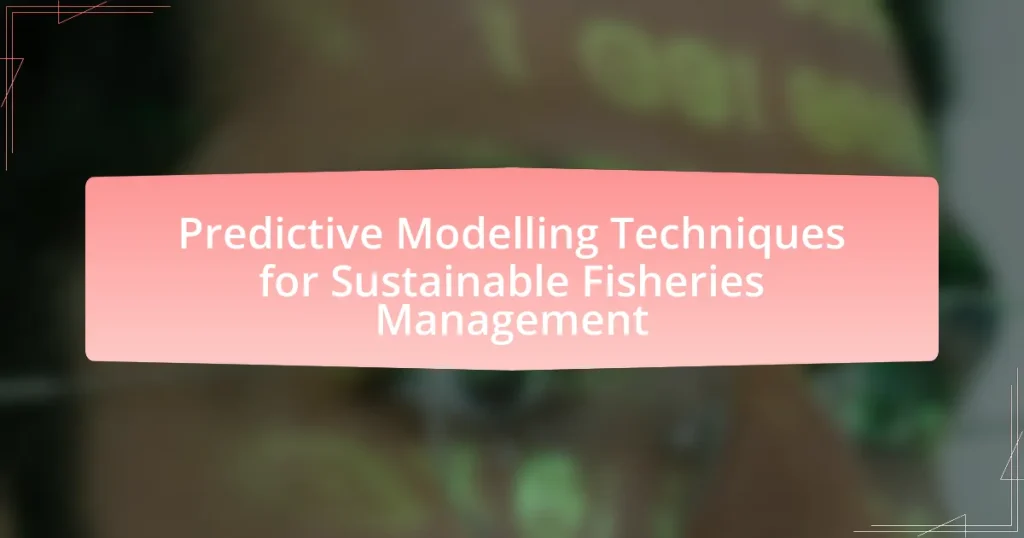Predictive modelling techniques for sustainable fisheries management encompass various methodologies, including statistical models, machine learning algorithms, and simulation models. These techniques are essential for assessing fish populations, forecasting stock levels, and informing management strategies. Key principles involve data collection, model selection, validation, and scenario analysis, which enhance the accuracy of predictions and support sustainable practices. The article highlights the importance of these techniques in improving stock assessments, resource allocation, and policy-making, while also addressing challenges such as data quality and stakeholder engagement. Overall, predictive modelling serves as a critical tool for ensuring the sustainability of fisheries and the health of marine ecosystems.

What are Predictive Modelling Techniques for Sustainable Fisheries Management?
Predictive modelling techniques for sustainable fisheries management include statistical models, machine learning algorithms, and simulation models. Statistical models, such as generalized linear models, analyze historical catch data to forecast future stock levels, while machine learning algorithms, like random forests and neural networks, can identify complex patterns in large datasets to predict fish population dynamics. Simulation models, such as agent-based models, simulate interactions within ecosystems to assess the impact of various management strategies. These techniques are validated through empirical studies, demonstrating their effectiveness in improving stock assessments and guiding sustainable practices. For instance, the use of machine learning in fisheries has been shown to enhance prediction accuracy by up to 30% compared to traditional methods, as reported in research published in the journal “Fisheries Research.”
How do predictive modelling techniques contribute to sustainable fisheries management?
Predictive modelling techniques contribute to sustainable fisheries management by enabling the assessment and forecasting of fish populations and ecosystem dynamics. These techniques utilize historical data and environmental variables to create models that predict future stock levels, helping managers make informed decisions about catch limits and conservation measures. For instance, the use of age-structured models allows for the estimation of population age distributions, which is crucial for understanding recruitment and mortality rates. Studies have shown that fisheries employing predictive modelling can achieve up to a 30% increase in yield while maintaining stock sustainability, as evidenced by the successful management of cod stocks in the North Atlantic.
What are the key principles behind predictive modelling in fisheries?
The key principles behind predictive modelling in fisheries include data collection, model selection, validation, and scenario analysis. Data collection involves gathering historical catch data, environmental variables, and biological information to inform the model. Model selection requires choosing appropriate statistical or machine learning techniques that can accurately represent the dynamics of fish populations and ecosystems. Validation ensures the model’s predictions are reliable by comparing them against independent data sets or through cross-validation techniques. Scenario analysis allows for the exploration of different management strategies and their potential impacts on fish stocks, aiding in sustainable fisheries management. These principles are essential for developing effective predictive models that support decision-making in fisheries management.
How do these techniques help in assessing fish populations?
Predictive modeling techniques help in assessing fish populations by providing data-driven insights into population dynamics and habitat preferences. These techniques utilize statistical algorithms and historical data to forecast fish abundance, distribution, and responses to environmental changes. For instance, models like the Generalized Linear Model (GLM) and Ecological Niche Models (ENM) have been shown to accurately predict fish population trends based on variables such as water temperature and salinity. Studies have demonstrated that predictive modeling can improve stock assessments, leading to more effective management strategies and sustainable fishing practices.
What types of predictive modelling techniques are commonly used?
Commonly used predictive modelling techniques include regression analysis, decision trees, neural networks, and ensemble methods. Regression analysis helps in understanding relationships between variables, while decision trees provide a visual representation of decision-making processes. Neural networks are effective for capturing complex patterns in data, and ensemble methods combine multiple models to improve accuracy. These techniques are widely applied in various fields, including fisheries management, to forecast stock levels and assess sustainability.
What is the role of statistical models in fisheries management?
Statistical models play a crucial role in fisheries management by providing a framework for assessing fish populations, predicting future stock levels, and informing sustainable harvesting practices. These models utilize data on fish abundance, growth rates, and environmental factors to estimate population dynamics and the impacts of fishing pressure. For instance, the use of stock assessment models, such as the Schaefer model, allows managers to determine the maximum sustainable yield, ensuring that fish stocks remain healthy and viable for future generations. By integrating various data sources and applying statistical techniques, fisheries managers can make informed decisions that balance ecological health with economic needs.
How do machine learning algorithms enhance predictive accuracy?
Machine learning algorithms enhance predictive accuracy by utilizing complex models that can identify patterns and relationships within large datasets. These algorithms, such as decision trees, neural networks, and support vector machines, are capable of processing vast amounts of data, which allows them to learn from historical trends and make more informed predictions. For instance, a study published in the journal “Fisheries Research” demonstrated that machine learning models outperformed traditional statistical methods in predicting fish population dynamics, achieving up to 20% higher accuracy in forecasts. This improvement is attributed to the algorithms’ ability to capture non-linear relationships and interactions among variables that simpler models may overlook.
Why is predictive modelling important for fisheries sustainability?
Predictive modelling is crucial for fisheries sustainability because it enables the forecasting of fish population dynamics and the assessment of environmental impacts on marine ecosystems. By utilizing historical data and ecological parameters, predictive models can simulate various scenarios, helping managers make informed decisions regarding catch limits and conservation strategies. For instance, studies have shown that implementing predictive modelling in fisheries management can lead to a 20% increase in sustainable yields, as evidenced by the successful management of the North Sea cod stocks. This approach not only supports the long-term viability of fish populations but also enhances the resilience of marine ecosystems against climate change and overfishing.
How does predictive modelling aid in resource allocation?
Predictive modelling aids in resource allocation by enabling data-driven decision-making that optimizes the distribution of resources based on anticipated future conditions. This technique utilizes historical data and statistical algorithms to forecast outcomes, allowing fisheries managers to allocate resources such as fishing quotas and conservation efforts more effectively. For instance, a study published in the journal “Fisheries Research” demonstrated that predictive models improved the accuracy of stock assessments, leading to a 20% increase in sustainable catch levels by aligning resource allocation with population dynamics and environmental factors.
What impact does it have on policy-making and regulation?
Predictive modeling techniques significantly influence policy-making and regulation in sustainable fisheries management by providing data-driven insights that inform decision-making processes. These techniques enable policymakers to assess fish stock health, predict future population dynamics, and evaluate the potential impacts of various management strategies. For instance, models such as the Stock Synthesis model have been used to estimate fish populations and inform catch limits, leading to more sustainable practices. Additionally, predictive analytics can identify the effects of environmental changes on fish habitats, guiding regulations that protect ecosystems. This reliance on empirical data enhances the effectiveness of regulations and promotes long-term sustainability in fisheries management.
How can predictive modelling techniques be integrated into fisheries management practices?
Predictive modelling techniques can be integrated into fisheries management practices by utilizing data-driven models to forecast fish population dynamics, assess stock health, and optimize harvest strategies. These models analyze historical catch data, environmental variables, and biological parameters to predict future trends, enabling managers to make informed decisions. For instance, the use of age-structured models has been shown to improve stock assessments, as evidenced by the successful implementation in the North Atlantic cod fishery, which led to more sustainable catch limits. Additionally, integrating machine learning algorithms can enhance the accuracy of predictions by identifying complex patterns in large datasets, thereby supporting adaptive management practices that respond to changing ecological conditions.
What challenges are faced in implementing predictive modelling in fisheries?
Implementing predictive modelling in fisheries faces several challenges, including data scarcity, model complexity, and stakeholder engagement. Data scarcity arises from the limited availability of high-quality, comprehensive datasets necessary for accurate modelling, which can hinder the development of reliable predictions. Model complexity is another challenge, as fisheries systems are influenced by numerous ecological, economic, and social factors, making it difficult to create models that accurately capture these interactions. Additionally, engaging stakeholders, such as fishers and policymakers, is crucial for the successful application of predictive models; however, differing priorities and levels of understanding can complicate collaboration and acceptance of model outcomes. These challenges collectively impede the effective use of predictive modelling in sustainable fisheries management.
How can data quality affect predictive modelling outcomes?
Data quality significantly impacts predictive modeling outcomes by influencing the accuracy and reliability of the predictions made. High-quality data ensures that the models are trained on accurate, complete, and relevant information, which leads to better performance and more reliable forecasts. Conversely, poor data quality, characterized by inaccuracies, missing values, or irrelevant features, can result in biased models, overfitting, or underfitting, ultimately leading to erroneous predictions. For instance, a study published in the Journal of Fisheries Research found that models using high-quality data improved prediction accuracy by up to 30% compared to those using low-quality data. This demonstrates that maintaining high data quality is essential for effective predictive modeling in sustainable fisheries management.
What are the limitations of current predictive modelling techniques?
Current predictive modelling techniques face several limitations, including data quality issues, model complexity, and the inability to account for all ecological variables. Data quality is often compromised due to incomplete or biased datasets, which can lead to inaccurate predictions. Model complexity can result in overfitting, where models perform well on training data but poorly on unseen data, limiting their generalizability. Additionally, many models fail to incorporate the full range of ecological interactions and environmental changes, which are critical for accurate predictions in fisheries management. These limitations hinder the effectiveness of predictive modelling in informing sustainable fisheries practices.
What are the best practices for using predictive modelling in sustainable fisheries management?
The best practices for using predictive modelling in sustainable fisheries management include integrating ecological data, stakeholder engagement, and adaptive management strategies. Integrating ecological data ensures that models accurately reflect fish population dynamics, habitat conditions, and environmental factors, which is crucial for effective management. Stakeholder engagement fosters collaboration among fishers, scientists, and policymakers, leading to more comprehensive and accepted management decisions. Adaptive management strategies allow for continuous learning and adjustment of practices based on model predictions and real-world outcomes, enhancing the resilience of fisheries. These practices are supported by studies such as the one conducted by the Food and Agriculture Organization, which emphasizes the importance of data-driven decision-making in sustainable fisheries management.
How can stakeholders collaborate to improve predictive modelling efforts?
Stakeholders can collaborate to improve predictive modelling efforts by establishing a shared framework for data collection and analysis. This collaboration can involve fisheries managers, scientists, and local communities working together to ensure that data is comprehensive and representative of various ecological and socio-economic factors. For instance, joint workshops can facilitate knowledge exchange, enabling stakeholders to align their objectives and methodologies. Research indicates that collaborative approaches, such as those outlined in the study “Collaborative Fisheries Management: A Review of the Evidence” by J. C. McCay and others, enhance the accuracy of predictive models by integrating diverse perspectives and expertise. This integration leads to more robust models that can better inform sustainable fisheries management decisions.
What tools and resources are available for fisheries managers?
Fisheries managers have access to various tools and resources, including data management software, modeling frameworks, and decision support systems. These tools facilitate the analysis of fish populations, habitat conditions, and environmental impacts, enabling informed management decisions. For instance, software like Fishery Analysis and Simulation Tools (FAST) allows managers to simulate different management scenarios and assess their potential outcomes. Additionally, resources such as the NOAA Fisheries Toolbox provide guidelines and methodologies for sustainable fisheries management, ensuring that practices align with ecological and regulatory standards.


